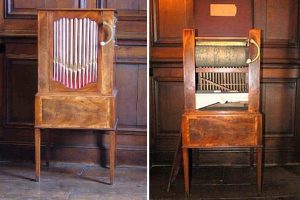An 18th-century Recording of Handel’s Recorder Sonata No. 4 in F Major
A barrel organ version of a familiar recorder sonata composed by George Frederic Handel around 1712, is, in effect, the nearest thing we have to an 18th-century recording. The barrel organ concerned was “pinned” by John Langshaw (1717–1798), an organist and mechanic, but the music itself is said to have been arranged by John Christopher Smith Jr (1712–1795), the son of Handel’s principal copyist, who later followed in his father’s footsteps and became Handel’s secretary and amanuensis. Smith Jr was himself an opera and theatre composer of some skill. Thus the organ might have an authoritative pedigree. However, concrete evidence to support this is lacking (Baines 2019: 25).
Until recently, only two recordings of the F major recorder sonata that I knew of made use of this seemingly authentic information. One is on a 1973 LP featuring David Munrow, namely The Amorous Flute. The other is found in Il Vero Modo’s 2004 recording Händel: A Flauto e Cembalo. Die sechs Sonaten für Blockflöte & Cembalo on which Sven Schwannberger and Thomas Leininger perform the same work alongside the composer’s other recorder sonatas to which Scwannberger applies the same ornamentation style. Both have been much criticised by reviewers and scholars alike. Lasocki (1978), for example, describes Munrow’s performance as “excruciatingly and appallingly bad” and the notion that Handel would have expected and enjoyed such ornamentation as “dangerous nonsense”. It seems hardly surprising that tastes in musical performance have changed so much over the last 300 years. Perhaps bad taste is to be found in any age. So much for all the hype about Historically Informed Performance (HIP)!
More recently, Emily Baines has released an arrangement of the Organ Concerto which Handel himself reworked around 1735 from his earlier recorder sonata on her CD The Ghost in the Machine (2021), taking her ornamentation from the barrel organ transcription.
Similarly, Dorothee Oberlinger has released her own arrangement on her CD Pastorale (2022).
The organ was built c. 1790 and is of a size suitable for use in a middle-class home. It has four ranks of pipes (stops) and three barrels. The barrels are inscribed “John Langshaw / Organ Maker / Lancaster”, and are assumed to be those originally housed in the instrument. The mahogany case is attributed to Gillows, a Lancaster furniture-making firm with which Langshaw is known to have collaborated. The instrument belongs to the collections of the Lancashire Museums and is currently on display at the Judges’ Lodgings Museum in the city of Lancaster, England.
You can listen to all four movements of the Handel recorder sonata played on the Langshaw barrel organ itself as follows:
A transcription of sorts of these movements can be downloaded and printed out here.
You can listen to the 1973 recording made by David Munrow, as follows:
It is interesting to compare it with that made some 30 years later by Sven Schwannberger, below. Note that this recording commences with an improvised prelude on the harpsichord.
You can listen to Emily Baines’ arrangement in concerto form here:
And you can watch and listen to Dorothee Oberlinger’s arrangement, also in concerto form, here:
To explore further examples of versions of music by Handel and his contemporaries recorded by mechanical instruments and their implications for HIP see Schwannberger & Leininger (2004) and Baines (2019, 2021).
References
- Baines, Emily J. 2019. “The Ghost in the Machine: The Role of Mechanical Musical Instruments as Primary Sources for Eighteenth-Century Performance Practice in England, and an Examination of the Style(s) Contained Therein.” Ph.D. dissertation, London: Guildhall School of Music and Drama.
- Baines, Emily J. and Amyas. 2021. The Ghost in the Machine. 18th-Century Music Inspired and Informed by Mechanical Musical Instruments. CD. First Hand Records 0000113FHR. https://laboiteamusique.eu/product/the-ghost-in-the-machine-emily-baines-amyas/.
- Dirksen, Pieter (ed.) 1987. George Frideric Handel: Twenty Pieces for a Musical Clock (c. 1838). The Diapson Press, Untrecht.
- Fuller, David. 1979. “Mechanical Musical Instruments as a Source for the Study of ‘Notes Inégales.’” Bulletin of the Musical Box Society International, Summer.
- Haspels, Jan J.L. 1987. Automatic Musical Instruments: Their Mechanics and Their Music, 1580-1820. Koedijk: Nirota, Muziekdruk C.V.
- Lasocki, David. 1978. A New Look at Handel’s Recorder Sonatas. I. Ornamentation in the First Movement of the F major Sonata. Recorder & Music 6: 2-9.
- Malloch, William. 1983. “The Earl of Bute’s machine organ: a touchstone of taste.” Early Music 11 (2): 172–184.
- Munrow, David, Oliver Brooks and Christopher Hogwood. 1973. LP: The Amorous Flute. Argo ZRG 746 (Decca). Reissued on CD by Virgin Veritas 7243612842 (1994) and Decca 440079 (1996).
- Oberlinger, Dorothee. 2022. CD, Digital (MP3, FLAC): Pastorale. Deutsche Harmonia Mundi DHM 19658745262.
- Ord-Hume, Arthur W.J.G. 1973. Clockwork Music: An Illustrated History of Mechanical Musical Instruments. Crown.
- Schwannberger, Sven and Thomas Leininger, as Il Vero Modo. 2004. CD: A flauto e cembalo. Die sechs Sonaten für Blockflöte & Cembalo. Thorofon CTH 2540 / LC 01958 (Bella Musica).
- Wikipedia. 2016. Langshaw Barrel Organ (Lancaster).
Cite this article as: Nicholas S. Lander. 1996–2025. Recorder Home Page: Handel and the Hype about HIP. Last accessed 3 July 2025. https://recorderhomepage.net/the-hype-about-hip/
